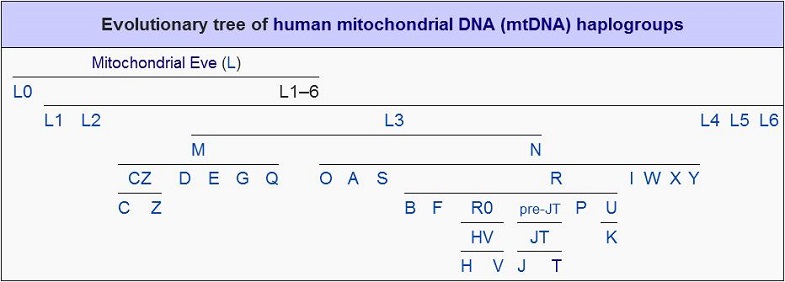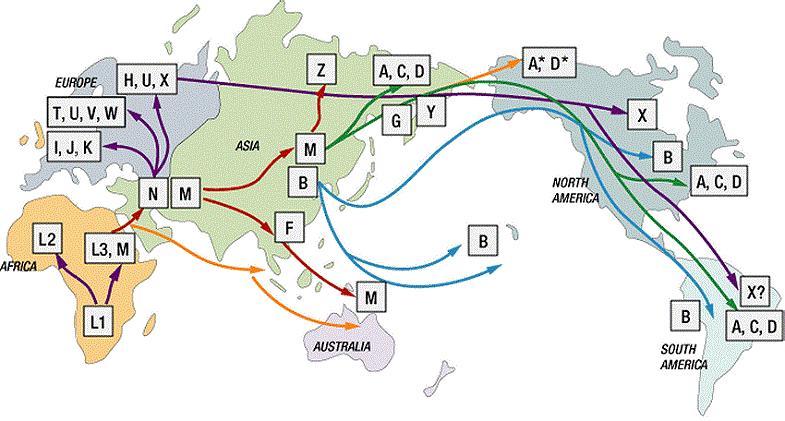|
The
|
||||||||||||||||||||||||||||||||||||||||||||||||||||||||||||||||||||||||||||||||||||||||||
THE BURGENLAND BUNCH NEWS - No. 261 November 30, 2015, © 2015 by The Burgenland Bunch All rights reserved. Permission to copy excerpts granted if credit is provided. Editor: Thomas Steichen (email: tj.steichen@comcast.net) Archives at: BB Newsletter Index Our 19th Year. The Burgenland Bunch Newsletter is issued monthly online. It was founded by Gerald Berghold (who retired from the BB in the Summer of 2008 and died in August 2008). |
||||||||||||||||||||||||||||||||||||||||||||||||||||||||||||||||||||||||||||||||||||||||||
Current Status Of The BB: * Members: 2389 * Surname Entries: 7700 * Query Board Entries: 5487 * Staff Members: 17 |
||||||||||||||||||||||||||||||||||||||||||||||||||||||||||||||||||||||||||||||||||||||||||
This newsletter concerns: 1) THE PRESIDENT'S CORNER 2) INFORMATION WANTED ON POELTL FAMILY IN THE LEHIGH VALLEY 3) MITOCHONDRIAL DNA 4) PORTLAND POINT, NY: A ONETIME BURGENLÄNDER COMMUNITY 5) BLESS MY HOMELAND FOREVER (by Rosemary Ruffenach) 6) HISTORICAL BB NEWSLETTER ARTICLES: - RUDERSDORF KRIEGSKINDER (RUDERSDORF CHILDREN OF THE WAR YEARS) - by Robert F. Unger 7) ETHNIC EVENTS 8) BURGENLAND EMIGRANT OBITUARIES (courtesy of Bob Strauch) |
||||||||||||||||||||||||||||||||||||||||||||||||||||||||||||||||||||||||||||||||||||||||||
1) THE PRESIDENT'S CORNER (by Tom Steichen)  Concerning
this newsletter, after the bits and pieces here in my "Corner," we start out with a request for
information in Article 2. BB member Jude Mulvey, a cousin to our Klaus Gerger, is
looking for Information About a branch on his family tree: the Poeltl
(Pöltl) Family. If you can help him out, please do! Concerning
this newsletter, after the bits and pieces here in my "Corner," we start out with a request for
information in Article 2. BB member Jude Mulvey, a cousin to our Klaus Gerger, is
looking for Information About a branch on his family tree: the Poeltl
(Pöltl) Family. If you can help him out, please do!Articles 3 is long and somewhat technical (sorry), but Mitochondrial DNA is a complex topic; I try to make it as simple as possible (but no simpler!). Article 4 arose from a comment I made last month concerning my travels in the Finger Lakes region of New York. That comment prompted Rachael (White) Dobšovičová to tell me all about Portland Point, NY: A Onetime Burgenländer Community. I hope you enjoy learning about the founding and eventual demise of a small community tied to the cement industry... and also to the Lehigh Valley. Article 5 is a Burgenländer family history, spanning the time from emigration in 1888 to well into the 1990s. In this article, titled "Bless My Homeland Forever," Rosemary Ruffenach tells us about her family's travails and about the matriarch, Mary (Peck) Laber, who tied her two Burgenland families together. The remaining articles are our standard sections: Historical Newsletter Articles, and the Ethnic Events and Emigrant Obituaries sections. 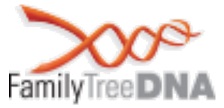 DNA
Testing Holiday Sale: FamilyTreeDNA is running their annual “holiday” sale on its
DNA tests. Through the end of the year, the mtDNA Full Sequence test has been reduced
from $199 to $169, the Y-DNA37 test is down from $169 to $139, the Y-DNA67 test
from $268 to $228, the Y-DNA111 test from $359 to $309 and the autosomal test has been
reduced from $99 to $89. DNA
Testing Holiday Sale: FamilyTreeDNA is running their annual “holiday” sale on its
DNA tests. Through the end of the year, the mtDNA Full Sequence test has been reduced
from $199 to $169, the Y-DNA37 test is down from $169 to $139, the Y-DNA67 test
from $268 to $228, the Y-DNA111 test from $359 to $309 and the autosomal test has been
reduced from $99 to $89. If you join the Burgenland DNA Study Project, Frank Paukowits (Group Administrator) will give people getting the mtDNA and Y-DNA tests an additional $30 rebate. 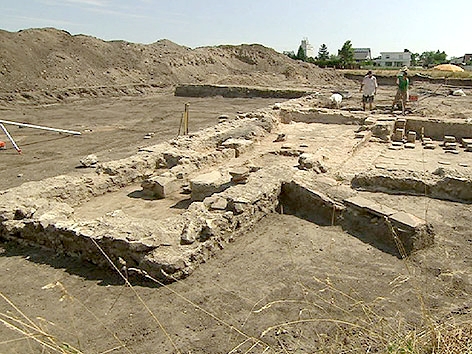 Roman
"Villa Rustica" Excavated in Deutschkreutz: Excavation of the foundations of a Roman
Villa Rustica dating from the third century AD were underway this summer and fall in
Deutschkreutz (in the Oberpullendorf district). The ruins, located up to 5 feet underground,
were mapped via ground-penetrating radar in 2009, however, the first indications of it were
artifacts found 90 years ago; a partial excavation was performed some 25 years ago. It was only
the pending construction of a housing project on the site that finally prompted a full and
proper archeological exploration on behalf of the Austrian Federal Monuments Office (Bundesdenkmalamt). Roman
"Villa Rustica" Excavated in Deutschkreutz: Excavation of the foundations of a Roman
Villa Rustica dating from the third century AD were underway this summer and fall in
Deutschkreutz (in the Oberpullendorf district). The ruins, located up to 5 feet underground,
were mapped via ground-penetrating radar in 2009, however, the first indications of it were
artifacts found 90 years ago; a partial excavation was performed some 25 years ago. It was only
the pending construction of a housing project on the site that finally prompted a full and
proper archeological exploration on behalf of the Austrian Federal Monuments Office (Bundesdenkmalamt).
The preliminary plan was only to measure and document the entire villa and its outbuildings, which cover an area of about 120 by 80 meters. However, the initial excavations, of the bathhouse and parts of the main building, revealed that the wall foundations were extremely well-preserved and of exceptional quality, likely indicating that the villa was more a palatial or luxury villa than a villa rustica. And this has prompted a rethinking! According to the excavation director, Nikolaus Franz, "If there is an opportunity to obtain such building structures and make them accessible to visitors then one must, in any case, take it." Meanwhile, the Federal Monuments Office placed it and adjoining land, on which more remains of the Villa are located, under a preservation order, saying it should be bought gradually and archeologically developed. 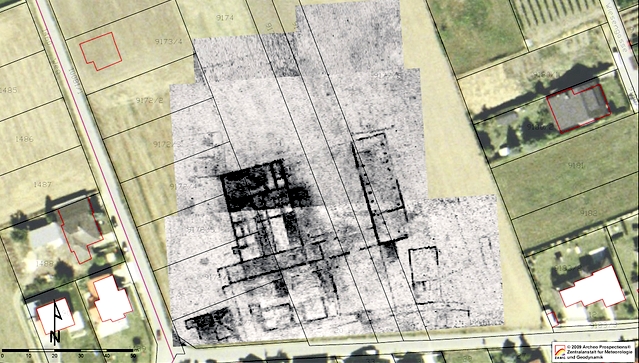
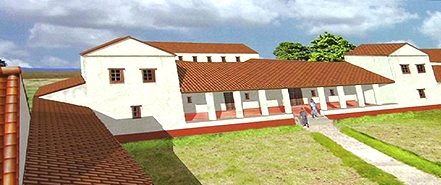 Radar map of the villa foundations and a speculative artist rendering of the main building.
The closest match on Richard's “one-to-many” list, George Lombardo, was discovered to
be a second cousin of to Richard by George's daughter, Nancy Robertson, nine years ago when both
were researching via Ancestry.com the same Zotter's in Neumarkt a/d Raab: János and
Theresia Holtzman Zotter, who married in 1837. (János and Theresia are Nancy's ggg-grandparents
through their son Ferencz, and they are Richard's gg-grandparents through their daughter Maria.)
|
||||||||||||||||||||||||||||||||||||||||||||||||||||||||||||||||||||||||||||||||||||||||||
2) INFORMATION WANTED ON POELTL FAMILY IN THE LEHIGH VALLEY Ed Note: BB member Jude Mulvey wrote to say that he has been working on a Gerger/Muik family history and asked if I would run a message in the newsletter expressing his wish to learn more, perhaps with the help of the BB newsletter readership. He says, "I am very interested in connecting with any members of my grandfather's family with whom we've now lost touch in the Lehigh Valley. My mom remembers vacations there but no names or addresses." As we are always interested in helping BB members learn more about their families, I said I'd be glad to run something in the next newsletter. The following is background on Jude's research and ends with the family sub-tree for which he desires more information. If you can help fill out or expand this tree, please contact Jude via his email address found here. Jude writes: My grandfather, John Gerger (1918-1991), regretted that he had lost contact with his relatives in Güssing. His parents, Johann (John) (1887-1969) and Gisela Muik Gerger (1890-1974) emigrated from Rosenberg, now part of Güssing. Johann arrived in the United States in 1906 and Gisela in 1907. They married in 1910 at St. Lawrence's Church in Troy, NY. I was attending the Universite de Fribourg in Fribourg, Switzerland, in 1985 when my grandfather urged me to visit Güssing to see if I could find any of his relatives, assuming any were left. I took a train from Fribourg to Vienna and a postal bus from Vienna to Güssing, arriving there with no idea of what to do next. My grandfather had given me the names of his parents but that’s all the information I had at that point; I didn’t even know the names of his grandparents. I went to the Güssing post office and asked the post mistress if there were any members of the Gerger family left in the town. She looked at me, and asked (in German; at that point I maintained my fluency in the language) why I was looking for them. I explained that my great-grandfather had been born in Güssing and that my grandfather wished he could find some of his relatives with whom his American family had lost touch. The postmistress asked me to wait, and left the room. I heard her speaking to someone on the telephone. She marched back into the room, and directed me to come with her, walking outside. After locking the door of the post office, she quickly walked down the street, not saying a word. We then got into her car (who would do that now?). She stopped at a house, knocked on the door and gave me a quick smile. She then turned and walked away, leaving me at the door by myself. The door opened and Maria Holler Gerger greeted me, and brought me into her home. Otto Gerger was sitting at the kitchen table. They both shook my hand, and asked if I could speak German. I responded in German and they both smiled at me. We sat at the table and I explained who I was and my relationship with the Gerger family. I sketched out a short family tree on a piece of paper and we were both surprised when we realized that Otto was my grandfather’s cousin. Otto’s grandfather Richard and John Gerger Sr. were brothers. Otto then called his younger sister Maria, who drove over to their house with her son, Franz Wagner. Maria and Franz drove me around Güssing, showing me the local church and castle, and then drove me over to Rosenberg. At Rosenberg, Maria pointed out the house where my great-grandfather had been born. The afternoon went by quickly and it was time for me to catch the next bus back to Vienna. We exchanged addresses, and the connection remains strong today. I later learned that Klaus Gerger, Otto’s son, was also just starting to research the family members who had emigrated from Güssing. Since that time, and with Klaus' help, I've been able to research many of the family from Güssing. But with the large number of emigrants, we also lost touch with the family members who immigrated to the Lehigh Valley in Pennsylvania. Our Allentown PA Connections Many of our family in Allentown on the Gerger side descend from the children of Joseph Poeltl and Theresia Sammerl. Their daughter Anna was the mother of John Gerger, Sr., my great-grandfather. Several of Anna Poeltl Gerger’s siblings, or their children, immigrated to Allentown in the Lehigh Valley of Pennsylvania. My Questions: Do any of you recognize these family members, children of Joseph Poeltl and Theresia Sammerl, and might you be able to help me fill in a more up-to-date family tree for them?
Any assistance will be greatly appreciated! |
||||||||||||||||||||||||||||||||||||||||||||||||||||||||||||||||||||||||||||||||||||||||||
3) MITOCHONDRIAL DNA 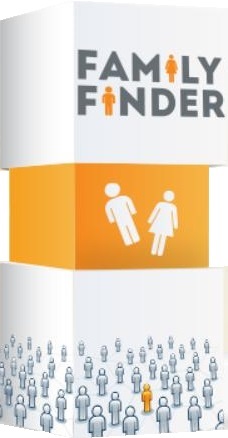 Last
Christmas, I purchased FamilyFinder autosomal DNA (atDNA) test kits from
FamilyTreeDNA for both my wife and me. Then a few months back, I included a short note in
the BB newsletter (NL # 258, 31 Aug 2015) reporting that "I had my first experience with a
DNA cousin that I could confirm as a real cousin": that is, a match via my atDNA
proved to be a second cousin who connects to me via the Burgenland part of my ancestry; he also
was one that my "conventional" records-based genealogy efforts had not yet found. Last
Christmas, I purchased FamilyFinder autosomal DNA (atDNA) test kits from
FamilyTreeDNA for both my wife and me. Then a few months back, I included a short note in
the BB newsletter (NL # 258, 31 Aug 2015) reporting that "I had my first experience with a
DNA cousin that I could confirm as a real cousin": that is, a match via my atDNA
proved to be a second cousin who connects to me via the Burgenland part of my ancestry; he also
was one that my "conventional" records-based genealogy efforts had not yet found. Just a few days before that note was published at the end of August, I chose to purchase FamilyTreeDNA mitochondrial DNA (mtDNA) mtFullSequence analyses to be performed on our kits, and I was notified that our results were available in mid-September. Since then, I have been learning how to interpret my results and I thought I'd share with you, the BB readership, what I've learned... thus this article! Perhaps I will enlighten you a bit and, better yet, if I say something foolish, perhaps someone will correct me so I can be enlightened too! 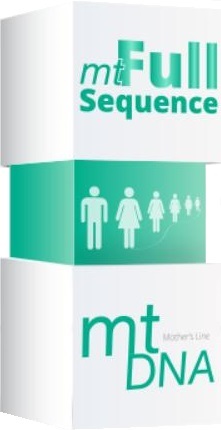 Given
I had already submitted DNA swabs to FamilyTreeDNA when I bought our autosomal
analyses, it was not necessary to be reswabbed for the mitochondrial analyses (reswabbing
would have been necessary had we chosen to change vendors). What pushed me to have the mtDNA
analysis done was two-fold. First, FamilyTreeDNA extended a limited-time 20% discount on
the $199 regular price of their mtFullSequence analysis. That dropped the price to
$159.20 ...and I doubted I would ever see a better price in the reasonably near future.
FamilyTreeDNA also offers what they call their mtDNA+ (or mtDNAplus, they list
it both ways) analysis for a regular price of $69, but that (as I'll describe more fully later)
does not offer nearly as much information, as it looks at less than 9% of the mitochondrial DNA.
The mtFullSequence analysis, as the name implies, analyzes every bit of it. Second, my
wife was pushing me to have more analyses done, and her interest was a big surprise to me! Given
I had already submitted DNA swabs to FamilyTreeDNA when I bought our autosomal
analyses, it was not necessary to be reswabbed for the mitochondrial analyses (reswabbing
would have been necessary had we chosen to change vendors). What pushed me to have the mtDNA
analysis done was two-fold. First, FamilyTreeDNA extended a limited-time 20% discount on
the $199 regular price of their mtFullSequence analysis. That dropped the price to
$159.20 ...and I doubted I would ever see a better price in the reasonably near future.
FamilyTreeDNA also offers what they call their mtDNA+ (or mtDNAplus, they list
it both ways) analysis for a regular price of $69, but that (as I'll describe more fully later)
does not offer nearly as much information, as it looks at less than 9% of the mitochondrial DNA.
The mtFullSequence analysis, as the name implies, analyzes every bit of it. Second, my
wife was pushing me to have more analyses done, and her interest was a big surprise to me!Of course, other vendors offer mtDNA analysis but, to be honest, I did not consider them, mostly because I was reasonably happy with what FamilyTreeDNA had provided for my prior autosomal test and I liked the idea of having all of my results available via just one log-in, and I presumed there would be no significant price difference between vendors for the mtDNA test as there was no difference in price for the atDNA tests [however, Richard Potetz tells me that 23andMe recently increased their atDNA test price from $99 to $199, as health reports are now included, so once-similar atDNA test prices now differ].
Autosomal is also good for confirming relationships among (relatively near) cousins. Given
the rather rapid dilution of shared inherited autosomal DNA (because it is a recombined mix from
that of the mother and father in each ancestral generation), current autosomal tests allow
identification only out to fourth or fifth cousins; beyond that, the amount of common DNA is too
little to be useful [where useful here means being statistically reliable for showing
relationships]. Further, having more than one common ancestor can cause the amount of shared DNA
to appear to indicate a closer relationship than is really true. This can occur if (as
was so common in feudal Burgenland) when shared ancestors lived for generations in just one
village, causing many of those ancestors to be interrelated in multiple ways. However, I have discovered that an up-to-date haplogroup assignment can always be obtained
from James Lick's mtHap utility at
http://dna.jameslick.com/mthap/, a tool that is usually updated within 24 hours of the
release of each new Phylotree build (this tool requires that you upload a FASTA-format
file for its analysis; the file can be generated easily within FamilyTreeDNA by clicking
the FASTA button at the bottom of the mtDNA Results page). Running the mtHap
utility against my mtDNA results, I discovered that my haplogroup assignment has now changed to
T2a1b1a1b (the last b is new; FamilyTreeDNA has me as just a T2a1b1a1).
As for my wife, her assignment did not change. [An alternative tool for determining an
up-to-date haplogroup assignment is HaploGrep2, found at:
http://haplogrep.uibk.ac.at/.]
For my haplogroup, T2a1b1a1, and relative to RSRS, all but the ones in
red or blue are considered defining
for the haplogroup... without some of these, I'd be in a different haplogroup. The colored ones
are considered "Extra" or "Private" (depending on whose terminology is used). |
||||||||||||||||||||||||||||||||||||||||||||||||||||||||||||||||||||||||||||||||||||||||||
4) PORTLAND POINT, NY: A ONETIME BURGENLÄNDER COMMUNITY I mentioned last month (as part of my explanation for the short October newsletter) that I had been traveling with my wife in the Finger Lakes area of western New York State, both to play tourist and to do some genealogy on my wife's side of the family tree in the town of Spencer, NY. That one-sentence comment prompted Rachael (White) Dobšovičová to send me a note: Rachael writes (in part): Dear Tom, I was so excited to read in the BB newsletter that you visited the Finger Lakes, as I am a Lansing native! Lansing is about 40 minutes north of Spencer, just north of Ithaca on the east side of Cayuga Lake. You picked a wonderful time of the year to go! I live in Vienna, Austria now, but spent my first 24 years in Lansing. I have a two-year-old and a four-year-old, so I haven't devoted enough time to reading the newsletter like I used to (member since 2003), but I hope to have time again in the future to go through all that I've missed. 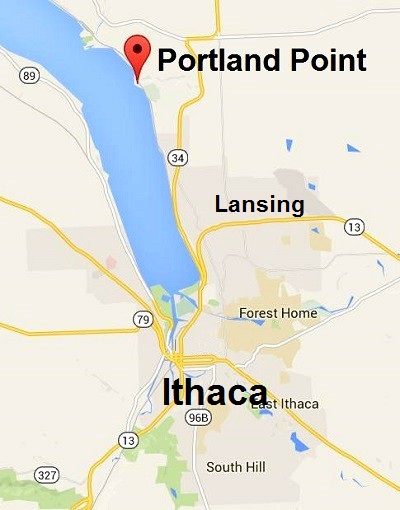 Three
of my maternal great-grandparents from Südburgenland (Moschendorf, Kleinmürbisch, and Inzenhof)
settled in Lansing 85-90 years ago. There used to be a small Penn-Dixie-owned village (15-20
houses) within Lansing on the lake at Portland Point for employees of the cement plant. When the
plant was shut down in 1947, the village was razed, and residents found housing in Lansing or
moved elsewhere. My great-grandparents remained in Lansing until their deaths in 1959, 1972, and
1982. My grandparents and the majority of my family still live there. Today, nothing remains of
the village of Portland Point except the foundations of some of the houses (on private property
and inaccessible). Three
of my maternal great-grandparents from Südburgenland (Moschendorf, Kleinmürbisch, and Inzenhof)
settled in Lansing 85-90 years ago. There used to be a small Penn-Dixie-owned village (15-20
houses) within Lansing on the lake at Portland Point for employees of the cement plant. When the
plant was shut down in 1947, the village was razed, and residents found housing in Lansing or
moved elsewhere. My great-grandparents remained in Lansing until their deaths in 1959, 1972, and
1982. My grandparents and the majority of my family still live there. Today, nothing remains of
the village of Portland Point except the foundations of some of the houses (on private property
and inaccessible). There were several residents of Portland Point from Burgenland, some were families and others were boarders. If you have access to the 1930 and 1940 Federal Censuses, you will see a plethora of Burgenland surnames there. A few families are still in Lansing and surrounding areas today, but quite a few were there just in the 1930's for work. [Inserted below] is a photo of Penn-Dixie Plant #7 and the village of Portland Point [visible in upper-center of photo] from ca. 1940 and the restaurant there run by my great-grandfather, John Wagner, of Moschendorf. 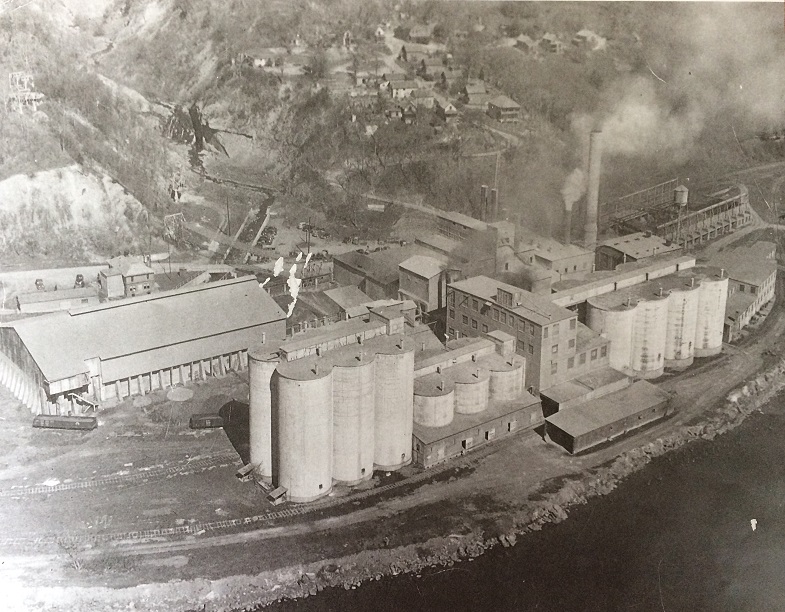
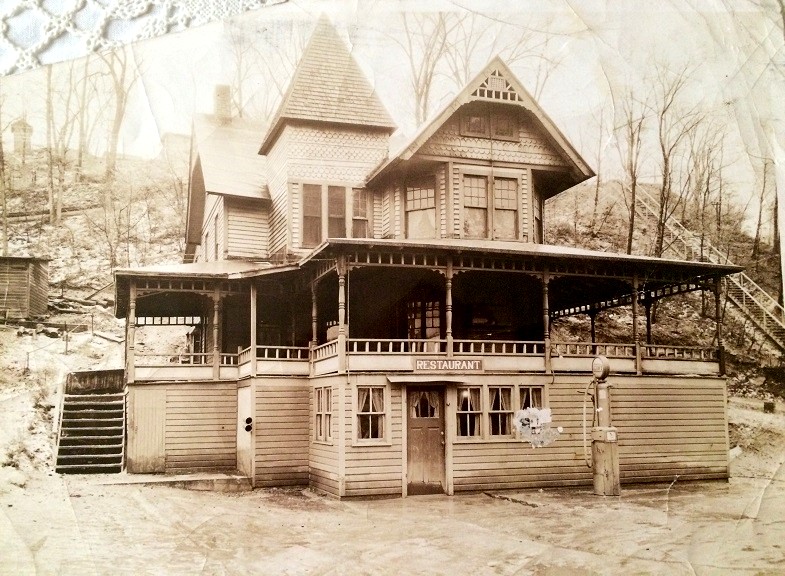 I replied (in part): Hi Rachael, I'm pleased to hear I found a topic that excited you, even if it was one sparked only by my vacation travels and the hunt for my wife's Finnish great aunt! Actually, I find your comments about cement manufacturing at Portland Point to be of great interest, as that industry brought many Burgenländers to the Lehigh Valley of Pennsylvania, as Coplay was the home to "Portland cement." I assume the facility in NY was a branch of the one in PA and that is why your people went up there (the "Penn-Dixie" name also gives a tie to PA!). Rachael replied (in part): Hi Tom, my great-grandfather, John Wagner, left Moschendorf in 1922 and first stayed with his aunt who had previously emigrated (Theresa Wagner Steltzman) in Northampton before moving up to Portland Point to work at the plant within a few years. My great-grandfather, Herman Ecker, left Kleinmürbisch in 1923 and moved to Stiles, where he lived until moving to Portland Point to work at the plant in 1930. His wife, Justina Fleischhacker Ecker, from Inzenhof joined him in PA in 1928. So the Lehigh Valley was their first stop, and their jobs at Pennsylvania-Dixie Cement Corp down there brought them up to the Portland Point plant. On her Facebook page, Rachael notes: The Penn-Dixie Cement Plant in Portland Point (Lansing), NY, employed primarily recent immigrants, particularly those from Burgenland, as the company was based in Easton, PA. In the 1930 and 1940 U.S. Federal Censuses, you can see the plethora of familiar Burgenland names in Portland Point. There were 243 residents in 1930 and 130 residents in 1940. Some names include: Crance, Trinkl, Wagner, Farkas, Theresa Gerger, Klement Deutsch, Frank Billowitz, Stukitz, Kroboth, Toth, Horvath, Martinek, Ecker, Domitrovits. Several are individual boarders, while others were families. Many remain in the area today. More information about the Portland Point Cement Works can be found in booklett: "This, Too, Happened in Lansing," by Isabelle H. Parish. Ithaca, NY: DeWitt Historical Society of Tompkins County, 1967. Here is the section on Portland Point: CEMENT WORKS AT PORTLAND POINT The Penn-Dixie cement works at Portland Point at one time produced 2,000 barrels of high-grade cement a day. However, the original operation had a humble beginning in the gullies above Shurger's Point. The gullies were part of the lot originally owned by Joseph Shurger, whose daughter Jane married Harts Collins (1832-1905). Collins recognized the value of the Tully limestone underlying the surface, mined the stone, burned it, and delivered the product to the Ithaca glass factories. It cost $3 a ton and sold for $8. After a time the Ithaca trade demanded white lime from gypsum. Collins then sent canalboats to Union Springs for gypsum rock, which he burned and delivered at a much higher price than the brown lime brought. 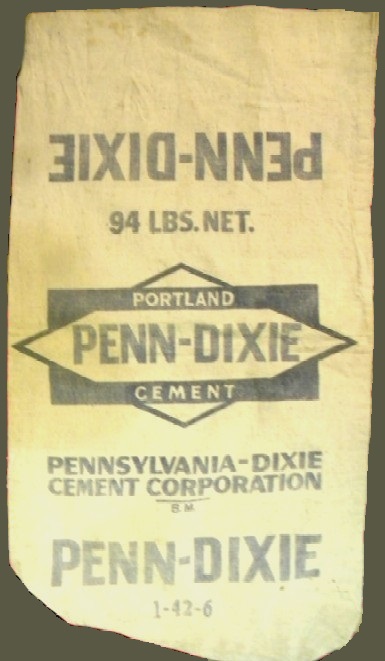 The
early kilns were very primitive and were operated with wood fires. About three weeks were
required to complete the process of combustion. Ashes that fell through the kiln were sold in
slaked form to farmers for fertilizer. After the death of Harts Collins, his son Sherman formed
the Portland Cement Company. During 1900 the works started on a site where Norton Creek enters
Cayuga Lake; an extensive operation, it was launched by the Cayuga Construction Company. The
early kilns were very primitive and were operated with wood fires. About three weeks were
required to complete the process of combustion. Ashes that fell through the kiln were sold in
slaked form to farmers for fertilizer. After the death of Harts Collins, his son Sherman formed
the Portland Cement Company. During 1900 the works started on a site where Norton Creek enters
Cayuga Lake; an extensive operation, it was launched by the Cayuga Construction Company.The quarry where the limestone rock was obtained was some distance up the hill to the east; a tramway transported the crushed limestone to the mill. By ingenious engineering, the loaded car descending the incline drew up an empty car. At the mill the limestone was burned, tested and sufficient gypsum added to bring it up to the high standards of quality that were maintained. Nearby was a large wooden building that contained a store operated by Ed Hance; upstairs was a boarding house managed by Erma Townley. Along the creek bank, a row of concrete garages, and on the hill to the south were a dozen or more houses built by the company for its employees. These houses were nicely furnished, for the men were well paid, and dwellings were set off by flower and vegetable gardens. There were an additional five or six houses near the quarry, but as the operations developed it displaced them. Now all of these houses are gone except for one that is occupied by a lone man. 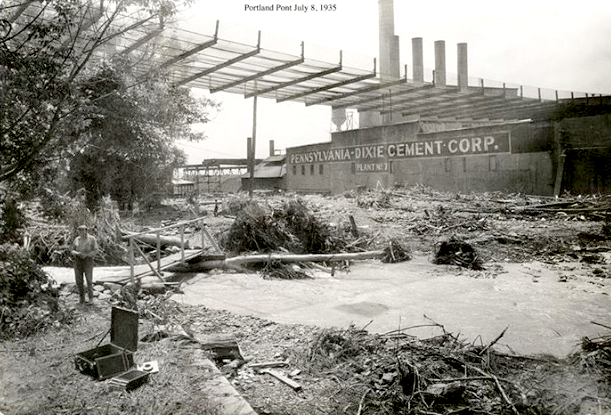 During
July 1935, this region experienced several days of hard rains that caused great floods which
took away the bridges at Myers and drowned three boys and a man. The waters washed away the
store building and garages and swept through the mill at Portland Point to leave the machinery
filled with mud. It required a year's effort to clean up this equipment before work was resumed. During
July 1935, this region experienced several days of hard rains that caused great floods which
took away the bridges at Myers and drowned three boys and a man. The waters washed away the
store building and garages and swept through the mill at Portland Point to leave the machinery
filled with mud. It required a year's effort to clean up this equipment before work was resumed.The cement was shipped by rail and the canal. Finally, after nearly 50 years of continuous production, the plant was closed in June 1947. At the time it was explained cement could be produced more efficiently at other plants of Penn-Dixie Cement Company of Easton, Pennsylvania, successor to the Portland concern. 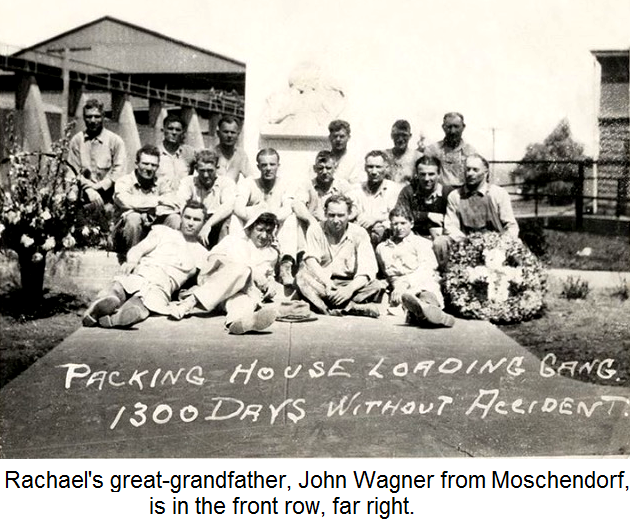 A
unique feature of the plant's management was a safety campaign inaugurated in 1925 and carried
on among the several plants of the company. A competition was established with a trophy awarded
the plant which operated a year without an accident. On June 1, 1931, employees of the Portland
Point plant and their families were given a holiday in observance of having gone all the year
1930 without loss of time through accidents. A
unique feature of the plant's management was a safety campaign inaugurated in 1925 and carried
on among the several plants of the company. A competition was established with a trophy awarded
the plant which operated a year without an accident. On June 1, 1931, employees of the Portland
Point plant and their families were given a holiday in observance of having gone all the year
1930 without loss of time through accidents.[The booklett is available in pdf form online at: http://tcpl.org/local-history/documents/towns-villages/This_Too_Happened.pdf.] |
||||||||||||||||||||||||||||||||||||||||||||||||||||||||||||||||||||||||||||||||||||||||||
5) BLESS MY HOMELAND FOREVER (by Rosemary Ruffenach) - Originally published in the Minnesota Genealogist, Vol. 38, No. 1, 2007. - Note: Square brackets around a number [1] indicate endnotes. “There was nothing for us there,” said John Peck, explaining why he and nearly sixty other villagers left northern Burgenland for America in 1888. The emigrants saw no future for themselves and their children in the borderland between Austria and Hungary. No new land was available for agriculture or cattle raising, the political situation was volatile, and the 1880’s prosperity of the Austro-Hungarian Empire hadn’t extended down the economic ladder to them. Situated on the border between Austria and Hungary, the Peck’s village of Andau, Burgenland, became a symbol of freedom fifty years ago. Then, 70,000 fleeing Hungarians managed to cross over the little wooden bridge spanning the Einserkanal, a narrow canal marking the border, and walk nine kilometers to the village before the Soviets blasted the bridge apart. But Burgenland, an Austrian province located about twenty miles south of Vienna, experienced tumultuous times long before the modern era. After centuries of periodic wars between the Hungarians and German Austrians, it found itself on the path of the armies of the Ottoman Turks heading into Austria in the 16th century. In 1594, the Pecks’ village of Andau [1] was torched by the imperial troops retreating to Vienna. In 1683, it was the Turks’ turn to lay waste to Andau. Only after the Turks were finally defeated outside of Vienna in 1687 could peasants return to the land. Two centuries later, the village had grown to 263 houses. Although the area—not named Burgenland until after World War I—was a part of Western Hungary at this time, residents of northern Burgenland spoke German rather than Latin or Magyar and identified with Austria. The Pecks, like seventy percent of Austrians, were Catholic. Two centuries earlier, the majority of villagers had been Lutheran, as Hungary embraced the Reformation. However, when the Habsburg monarchs enforced penalties on Protestants during the Counter Reformation starting in 1671, membership in those churches dropped off. Limited freedom of worship was allowed after the Patent of Toleration was decreed in 1781. Not until 1867 was religious freedom declared a right. Life was not easy in Burgenland in the 1870s. A worldwide economic depression struck in 1873, following the crash of the Vienna Stock Exchange, one of the oldest in the world. That same year a cholera epidemic swept through the village, leaving 112 people dead. Three years later Burgenland saw a period of disasters: • 1876: constant rainstorms in February and March, followed by very hot weather • 1879: severe storms damage crops • 1882: village cows die from disease • 1883: extreme cold • 1885: severe drought • 1886: a long, cold winter • 1887: rainstorms causing the hay to rot in the fields • 1888: very long, cold winter with unusually large snowfalls. Like Andau, the village of St. Andrä [2], about five miles to the west and home to the Laber family, had also been deserted for the 200 years prior to 1690 because of extended warfare. When resettled, the new inhabitants, thought to be ‘meadow farmers’ from southern Germany, were granted tax-free status for six years. During the 1870s and 1880s, St. Andrä's villagers experienced the same disasters as did Andau’s. Both villages were also anxious about the possibility of war with Russia and conscription of their young men. Today, St. Andrä, near the shores of shallow Lake Neusiedler (Neusiedler See), is the kick-off point for cyclists and enthusiastic bird watchers heading into Lake Neusiedler National Park. The park’s saltwater pools and reed beds attract flocks of migrating birds, including tens of thousands of geese in the spring and fall, and protects the great bustard, an endangered species. But what today is a protected habitat and fine wine-growing country wouldn’t have been very hospitable territory for Laber families trying to make ends meet in 1888. Indeed, the area where the alpine climate of the Alps meets the great Hungarian plain or puszta might have seemed to them a barren land, the literal translation of puszta. One of the determining factors for the Pecks’ departure was the possibility that eldest son Leo would be drafted into the Imperial Army. Although families from Andau had started emigrating in 1880 and recruiters painted a rosy picture of life in America, Elizabeth Fangl Peck had been averse to emigrating, not wanting to leave her family and all that she knew. As her eldest son neared conscription age, however, and her younger sister Eva Fangl Gelbmann and her husband Joseph finally agreed to emigrate, Elizabeth consented to leave Andau. Coupled with these incentives to leave was the lure of a better life in America. Letters home from those who had emigrated earlier, some to Minnesota, gave credence to the bright prospects painted by the mission societies and railroad line agents. So in early 1888, John Peck sold all the family’s belongings to pay for their and the Gelbmanns' fares. Thus it was that John Peck at age 52 and Elizabeth Fangl Peck, age 41, and their five children were among the sixty-four persons who traveled to Vienna on the first leg of their journey. Other Andau immigrants were Joseph Gelbmann, age 29, his wife Eva, age 26, and their two children, a two-year-old and a baby; Lorenz Peck and his wife; a single sister, Theresa Peck; and two Sattler families. Two other adult single Peck women, Maria and Suzanna, emigrated the next year. Upon reaching Vienna, the 1888 immigrants learned that Canada, like the Empire, had mandatory conscription, so they exchanged their tickets to Canada for Minnesota, where, they were told, opportunity was the greatest. From Vienna, they traveled northwest to Rotterdam, Netherlands, the largest port in Europe. [3] The Pecks boarded the Dutch ship SS Leerdam, carrying 750 passengers and arriving in New York City 16 April 1888. Imagine their awe at first catching sight of the new Statue of Liberty, which had only been in place a year and a half, having been dedicated by President Grover Cleveland on 28 October 1886. They debarked at Castle Garden, a circular, red granite, thick-walled fortress in lower Manhattan built in 1808. It was refurbished as a landing depot by the State of New York and opened in 1855. By 1888, it was severely run-down, reflecting its hard use serving eight million immigrants—two out of three immigrants entering the United States between 1855 and 1889. At Castle Garden, the immigrants would have been separated from their luggage and, under its central glass dome, lined up before the registrar, who would check them off the list provided by the ship’s master. Ill immigrants were sent to the state hospital to receive medical treatment; those with communicable diseases were denied admittance. (One of the family’s relatives emigrated somewhat later with a newborn child who died on the voyage. Desperate that the child not be buried at sea, the mother hid the child’s death from the ship’s crew by sprinkling the corpse with perfume, and even managed to get the corpse through the customs check when the ship docked.) Although the Castle Garden facility was intended to protect immigrants from the swindlers prowling the docks, one of the Andau group did get fleeced. Maria (Mary) Peck, then 13 years old, later recounted how a man from their party went to purchase a beer upon arriving on the New York wharf. When her father asked what the fellow had paid for the bottle, his fellow passenger reported that he had been quite smart. He had only given his smallest coin for the beer, yet received back several much larger coins. Only later did he discover that a five dollar gold piece should have bought him a barrel of beer. From New York, the party took the train to Saint Paul, where their travel agent and guide purchased them a meal and promptly disappeared, leaving them standing on the street in the April cold. Luckily, a German-speaking citizen took pity on them and guided them to an unfinished house he was constructing, where they spent the night. The next night they crowded into a vacant butcher shop. The Laber Family Follows It took the Labers over in St. Andrä another two years to decide it was time to leave. Besides economic pressures, the family was also facing conscription of the oldest son, Joseph, then 15. Father, Matthew Laber, at age 48, and his two older daughters Catherine and Elizabeth, left first, intending to get settled before his wife, Elizabeth Pffeffer Laber, and their three younger children came over. Elizabeth, age 42, followed in October 1890 aboard the SS Veendam out of Rotterdam with children Joseph, Martin, age six, and Theresia, age four. By this time, Castle Garden had been closed and new arrivals were processed in a temporary center in the old Barge Office at the southeast end of Manhattan. (Ellis Island didn’t open until 1 January 1892.) In Saint Paul, the Pecks, Labers, and Sattlers gravitated to the North End, an area just north of the state capitol that had attracted immigrants from the Austro-Hungarian Empire. The southern third of the area was first platted for housing in 1857, and by 1870 plats extended a mile north to Maryland Avenue. During the 1880s the North End had filled with German-speaking immigrants, many of whom worked in the railroad yards along its southern border. Just a year before the Burgenland group arrived, the city had annexed all of the North End. Thus, by 1890, newer immigrants were settling further north, nearer Maryland Avenue. So large was its German-speaking population that the area between Western and Jackson, and Hatch and Maryland avenues, became known as “Little Bavaria,” despite it also hosting Hungarian, Polish, and Bohemian householders. As years passed, the area became known for its stability, with families living in the community for several generations and often choosing homes only a few blocks from their birthplaces when starting a new family. 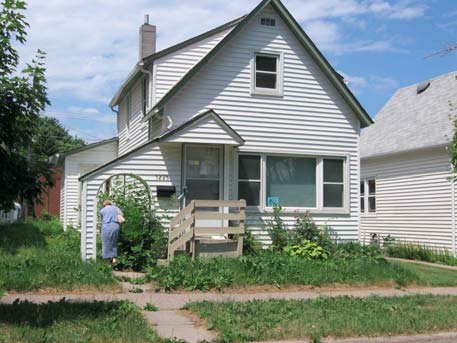 One
Austrian family occupied a complete city block. The Pecks and Labers followed this pattern. The
Pecks had settled at 1225 Woodbridge Street by 1893 and stayed there, with John listed as a
“laborer” in the city directory until 1911, when he was 75. After John’s death in 1914,
Elizabeth moved in with their married daughter, Elizabeth Peck Tell, and her family in
Minneapolis. Son Leonard married within a decade of arriving and moved into 1223 Woodbridge
Street. Their third son, Martin, age three at the time of emigration, later came to reside at
1186 Woodbridge Street, and grandson Bernard (son of John Peck, Jr. and Eva Laber) moved in down
the street at 21 East Maryland Avenue. On a recent visit to the 1225 address, I had to wonder
how the John Pecks, a family of seven, squeezed into the small, two-story home now sitting
empty. The answer apparently is that not all were home at the same time. One
Austrian family occupied a complete city block. The Pecks and Labers followed this pattern. The
Pecks had settled at 1225 Woodbridge Street by 1893 and stayed there, with John listed as a
“laborer” in the city directory until 1911, when he was 75. After John’s death in 1914,
Elizabeth moved in with their married daughter, Elizabeth Peck Tell, and her family in
Minneapolis. Son Leonard married within a decade of arriving and moved into 1223 Woodbridge
Street. Their third son, Martin, age three at the time of emigration, later came to reside at
1186 Woodbridge Street, and grandson Bernard (son of John Peck, Jr. and Eva Laber) moved in down
the street at 21 East Maryland Avenue. On a recent visit to the 1225 address, I had to wonder
how the John Pecks, a family of seven, squeezed into the small, two-story home now sitting
empty. The answer apparently is that not all were home at the same time.Although the Gelbmanns first rented in the Dayton’s Bluff neighborhood on Saint Paul’s East Side, they were living two doors south of the Pecks by 1894, at 1221 Woodbridge Street. Joseph Gelbmann worked as a foreman at the wholesale grocers Koehler & Heinrichs, located at Seventh Street in downtown Saint Paul. In retirement, Joseph and Eva lived at 1300 Woodbridge Street with son John. The Sattlers, who had emigrated in the 1888 group, settled at 233 Maryland Avenue, a few blocks south of the Pecks and Gelbmanns. Mike Fangl, Elizabeth Fangl Peck’s cousin, and his wife Marie Sattler emigrated in 1889, and first lived with the Gelbmanns. Mike later worked with Joseph Gelbmann at K & H Grocers. Thus, the Andau families followed the classic sequential migration pattern, wherein a first group of immigrants travels to a new land and is subsequently joined by relatives and others from their home area as they settle in and achieve some stability in their new lives. Later, many of the next generation also choose homes in the same neighborhood. Unlike other families, the Pecks and Labers didn’t lose any children. Unfortunately, Mike Fangl and Marie Sattler lost five of their fifteen children before they left Andau, emigrating with only their 5- and 2-year-olds. In Saint Paul, another child died shortly after birth and then Mike succumbed to cancer at age 49, leaving Maria with nine children between the ages of 5 and 21. Four more of her children died of tuberculosis. By the time Marie died in 1930, she had outlived all but three of her fifteen children. A neighbor who settled further north toward Roseville ended up digging seven graves on their property for all their stillborn children. The Labers, arriving in Saint Paul two years after the Pecks, also chose living quarters in the North End area, but east of Rice Street. They moved frequently, although each time within a few blocks of their former residence, indicating that they rented for a number of years before settling in at 10 Jessamine Avenue East. The single-story cottage, now also sitting vacant, is even smaller than the Pecks’ home west of Rice Street. Mathias Laber is listed in the city directories as a laborer first at the Northern Pacific Railway and then at the public works. After his death in 1924, his widow moved in with members of the Peck family in a large house at 21 Maryland Avenue East. 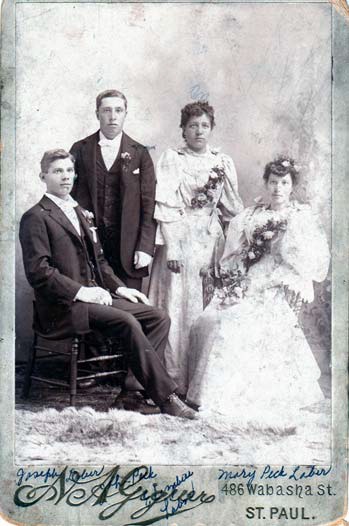 It
is with Mathias’s son Joseph that the Labers and Pecks lines join. He and Mary Peck
married in 1895, when both were 21. By then, Joseph was employed as a cigar maker at Kuhles
and Stock Company, a job he took at 18 and remained at during his short life. Also at age
18, Mary found work as a seamstress at Kuhl and Cumming Company. Their wedding photograph
shows Mary in a dress she must have made herself; standing behind the couple are his sister and
her brother, who also married. Joseph and Mary set up residence on Cook Avenue, two blocks away
from his parents on Jessamine. The next year, Catherine, the eldest of their five children was
born; and every second year thereafter, another child entered the family: Martha, Joseph,
Albert, and Theodore. Meanwhile, the other Laber-Peck couple, Elizabeth Laber and John Peck,
started their family of seven children. Imagine the confusion as they conferred on their
children the family names of John, Elizabeth, Mathias, and Joseph! It
is with Mathias’s son Joseph that the Labers and Pecks lines join. He and Mary Peck
married in 1895, when both were 21. By then, Joseph was employed as a cigar maker at Kuhles
and Stock Company, a job he took at 18 and remained at during his short life. Also at age
18, Mary found work as a seamstress at Kuhl and Cumming Company. Their wedding photograph
shows Mary in a dress she must have made herself; standing behind the couple are his sister and
her brother, who also married. Joseph and Mary set up residence on Cook Avenue, two blocks away
from his parents on Jessamine. The next year, Catherine, the eldest of their five children was
born; and every second year thereafter, another child entered the family: Martha, Joseph,
Albert, and Theodore. Meanwhile, the other Laber-Peck couple, Elizabeth Laber and John Peck,
started their family of seven children. Imagine the confusion as they conferred on their
children the family names of John, Elizabeth, Mathias, and Joseph!Saint Bernard’s Catholic Church, located on the corner of Albemarle and Rose streets, and just down the street from the Pecks, became central to the lives of the new arrivals. In the late 1880s, the need for a Catholic church in the North End was becoming critical. Catholics living in the area were forced to travel to Assumption Church in downtown Saint Paul to attend services. When one young woman nearly froze to death on this trek and Reverend Bernard Locnikar found visiting the North End sick in winter extremely hazardous, he went about organizing a new parish. [4] He solicited the support of Archbishop Ireland and the Catholic families in the district during 1889-1890. By February 1891, a school enrolling 220 pupils was opened in a new two-story structure—still under construction, with the second floor temporarily hosting the church. Among the organizers of the parish were the Gelbmanns and Janisches (Mathias Laber’s older sister Catherine, known as Janisch Tante, and her husband Joseph Janisch). The Pecks are listed as pioneer members. 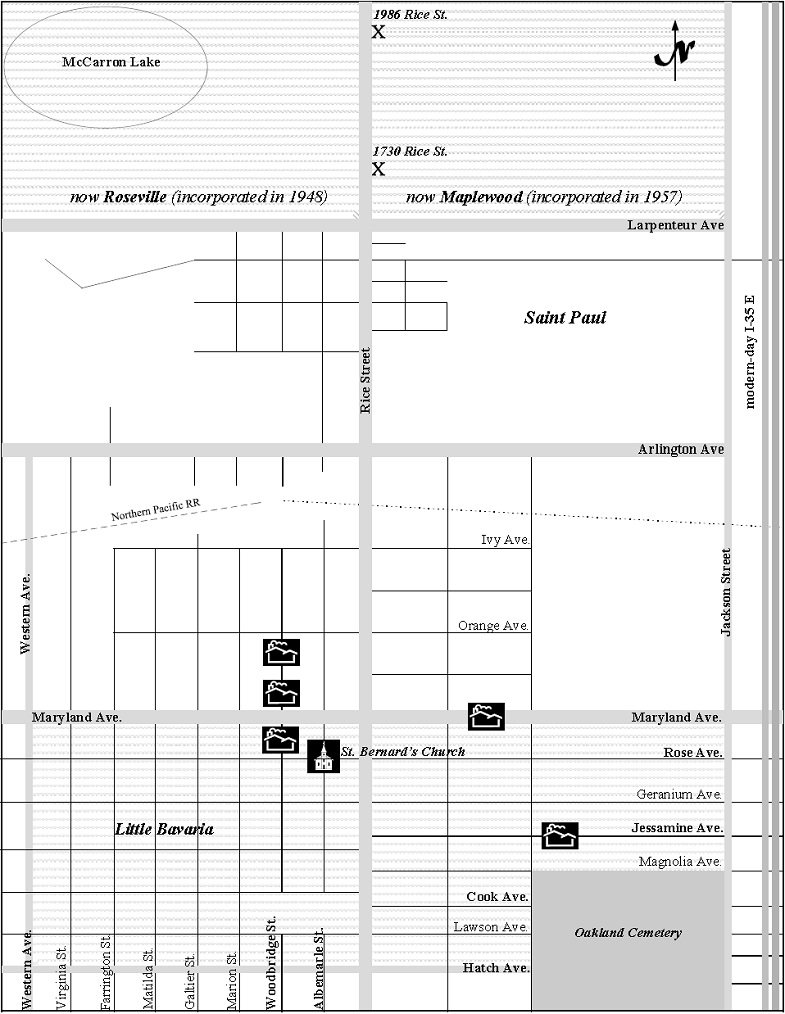 Map of the area in St. Paul where the Pecks and Labers lived. 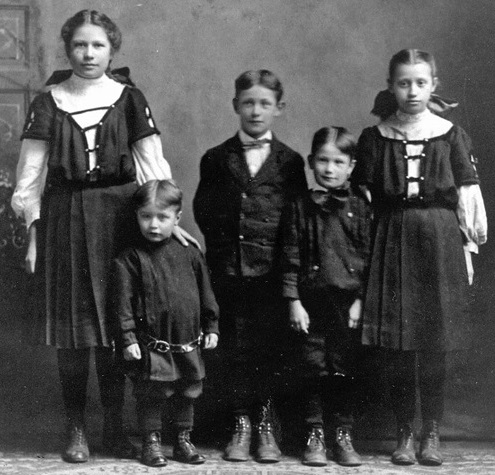 Naturally,
the Laber children were sent to Saint Bernard’s School. A 1907 photograph of Catherine
and her fifth grade classmates reveals forty-two students in a high-ceilinged classroom, boys on
one side and girls on the other. There was much back-and-forthing between the extended families,
and every Monday morning Elizabeth Peck would arrive to help daughter Mary with the washing. All
was going well until youngest son Theodore (Ted) Laber came down with the chicken pox in 1911.
Joseph Laber caught the illness and soon died. Although the extended families helped out as much
as they could, his widow Mary couldn’t make ends meet and so set about finding work. At first
that was cleaning houses. One of the homes she cleaned was that of the Schroeders, owners of
Schroeder Milk Company. Through that connection she was offered the management of a grocery
store and a gas pump—that had to be pumped by hand—owned by Mr. Dean, located further up Rice
Street. Later a 3.2 bar was added to the establishment. That opportunity brought financial
stability to the family. [5] These were hard times, but Mary Laber could proudly declare that no
one ever saw her cry. If things got too bad, she recalled, she would “go outside and hang on
the cow and cry.” Naturally,
the Laber children were sent to Saint Bernard’s School. A 1907 photograph of Catherine
and her fifth grade classmates reveals forty-two students in a high-ceilinged classroom, boys on
one side and girls on the other. There was much back-and-forthing between the extended families,
and every Monday morning Elizabeth Peck would arrive to help daughter Mary with the washing. All
was going well until youngest son Theodore (Ted) Laber came down with the chicken pox in 1911.
Joseph Laber caught the illness and soon died. Although the extended families helped out as much
as they could, his widow Mary couldn’t make ends meet and so set about finding work. At first
that was cleaning houses. One of the homes she cleaned was that of the Schroeders, owners of
Schroeder Milk Company. Through that connection she was offered the management of a grocery
store and a gas pump—that had to be pumped by hand—owned by Mr. Dean, located further up Rice
Street. Later a 3.2 bar was added to the establishment. That opportunity brought financial
stability to the family. [5] These were hard times, but Mary Laber could proudly declare that no
one ever saw her cry. If things got too bad, she recalled, she would “go outside and hang on
the cow and cry.”About the time of her father’s death, Catherine was in eighth grade and ready to graduate. An option a very few students took at this time was to matriculate on to the public high school. Catherine did not. Her eighth-grade essay book contains research on the Fireside Poets (including Longfellow and Whittier), copies of poems that she liked, and essays on the seasons written in German in a lovely hand. Upon graduation, she went to work in a shoe factory. Her brother Joseph, full of high jinx, was asked to leave school before graduation. To accommodate Mary’s new employment situation, the Laber family moved northwards to a house located on a larger parcel of land just outside the city limits, on the north side of Larpenteur Avenue a bit east of Rice Street. The corn crib near the house was moved over to the Dean’s to serve as the gas “station”; later it stored the stock for son Ted’s popping corn business and tip boards, and finally became a pigeon coop. In the basement of the house, pork was prepared. Pigs were hit over the head with an ax and stuck to bleed out, and then all parts were used. From their new residence, the children carried eggs and milk from their chickens and cow to their grandparents while on the way to Saint Bernard’s. The boys recall that sometimes they were offered a lift by railroader James J. Hill as they trudged back and forth to school—he on his way to or from his North Oaks farm. Lifts from the Hills became a tradition that lasted until World War II, when teenager Joe Laber III was offered rides by Louie Hill in his “big, black Lincoln” when walking to and from work at the Soo Line yards. (Louis W. Hill, Sr., would often visit Laber Liquors to stock up.) By 1913, at age 16, Catherine was working at the O’Donnel Shoe Company. She, and a group of girlfriends who called themselves the O’Donnel Hens, arranged boating, picnicking, and swimming outings on the local lakes. It was through her best friend Anne Olson (later Welter) that another Hill family connection was formed. Anne worked in the kitchen at the Hill mansion on Summit Avenue and when there was a need for extra help, for spring-cleaning or the Christmas holidays, Catherine was hired on temporarily. The girls would snoop about the house when the Hills were out of town or at their North Oaks farm. It was in this way that Catherine learned what the cubbyholes near the fireplace in Mrs. Hill’s bedroom were for. When touring the house many years later, her daughter could tell the mystified guide that the cubbyholes were designed as shoe warmers for Mrs. Hill’s many pairs. The Laber boys inherited a love of the outdoors and fishing and hunting from their father—and what better place to enjoy those pastimes than in the preserves north of the city? No matter that the chain of small lakes—Charley, Gilfillan, Big, and Deep lakes— were posted “No Hunting or Fishing.” Their strategy was to have someone drop them off, sneak into the preserve near the park superintendent’s house, and scoop up fish. When the tubs were full, they hauled them to the road and waited in a ditch by the bend in Rice Street (near the location of the Hill family cemetery) for a car to pick them up at an appointed time. One day an exasperated game warden strode into the Laber bar and announced that some day he would catch the young poachers. He never did. It was in 1917 that Mary Laber had to face what she recalled as “the hardest thing in her life”: Joe Junior entering the service to fight in World War I. When Catherine’s beau, Peter Ruffenach, was also drafted, Mary pessimistically warned her daughter that he would never return from the war. Luckily, the day Peter reported to the draft office, the armistice was declared. So that year Catherine could marry Peter, a “Frenchie” as she called him, from Minneapolis. (Actually his heritage was Alsatian and German.) They had met when both were in Anne Olson Welter’s wedding party, and although he had danced with others all evening at the wedding festivities, it was Kate he asked to escort home. In the following months, he courted Kate on his motorcycle and, by the time she was 21, they had married and moved across the river. When reminiscing in her 90s, Kate said that she had hesitated to marry since she was having way too much fun being single. But her girlfriends were all marrying, so she did too. The Roaring Twenties Many family stories date back to the Twenties, a roaring decade for the Labers. Son Ted and friend Jimmy Dean started out adult life by working their way across country, often helping in hayfields. From there he moved into boxing and selling popping corn. Soon Ted and sister Martha had the funds to purchase a Model A convertible and show it off by touring up and down Rice Street, a one-lane road in those days. A nephew recalls lying on the car’s back window ledge on those hectic drives. On weekends the young people would load up farm trucks and head out to the lakes. When a little older, Ted graduated to Prohibition “rum running.” Although family stories have Ted picking up liquor in Milwaukee and bringing it through Canada to Minnesota, given the geography, it seems more logical to suspect that he ran it across Wisconsin to St. Paul, or smuggled Canadian-made liquor across the border. Meanwhile, the other Labers made “hooch” and root beer in the basement of what was called “the yellow house” on Larpenteur and even devised their own bottle capping system. A nephew, Jerome Ruffenach, recalls that Ted and his buddy “Doc” Schroeder, who owned an airplane and a sporty Stuz Bearcat, would have glitzy girls down from Chicago. As a five-year-old, he would get to ride in the car on the girls’ laps, and unfortunately, once had an accident thereon. Another time he was taken on one of the rum runs as a decoy. It was in those years that Mary Laber started calling Ted something that sounded like “Hon.” When later confronted by a daughter-in-law about this apparent favoritism, she explained that she was actually calling him “Hun”—a motherly response to his wild behavior, which reminded her of those earlier ancestors. In the mid-1930s, when Mr. Dean decided he had another use for his building, Mary Laber, with son Ted’s help, built a brick building at 1730 Rice Street, housing a grocery store, bar, and apartment. A while before, when Mary was considering setting up her own establishment, a businessman patron had invited her to come to him when she needed a loan. When she did so, he asked what she had for collateral. “My children,” she had replied. It wasn’t enough for the banker, so no loan. Later, however, help from her children was enough. Mary, daughter Martha, and son Ted, who had all been living in the apartment in the rear of the Dean store and bar, now were able to move into their own building. Matt Laber, brother of the long-deceased Joseph Senior, wintered in the store basement when he could no longer spend time in the outdoors hunting and fishing. Joe Junior had married Catherine Struntz, a Saint Bernard’s girl, in 1927 and had started a family, so they were now in the yellow house. Joe was working for the Peoples’ Ice Company, which operated an ice warehouse at Rice Street and Jessamine Avenue and took its ice out of Lake Owasso and McCarron's Lake. Joe must have fondly recalled his early expeditions to the Hill Farm in North Oaks, because he was known to take his nephew Jerome there to hunt rabbit well into the mid-1930s. (It was still considered poaching.) Mary’s son Albert was just about to marry when his chosen, Rose Peters, was diagnosed with tuberculosis. She spent a year at the Lake Owasso Preventorium, her wedding dress in storage, until she recovered. Then their marriage was celebrated with a shivaree (defined as “clamorous salutation made to a newlywed couple by an assembled crowd of neighbors and friends”). Al continued to work in the Ziittel Greenhouses on Rice Street, and later took over the Standard Oil service station on the corner of Rice and Larpenteur. 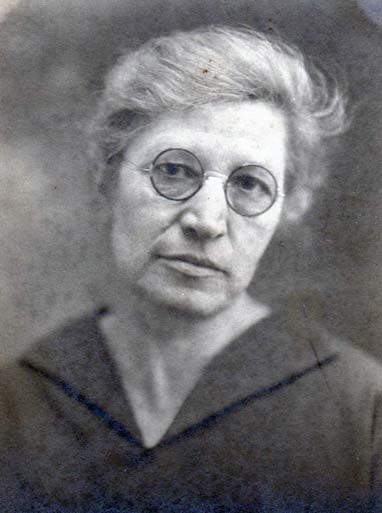 During
the next several decades, a customer could find various games of chance at the Laber bar.
A grandchild of “Grandma Laber,” as Mary Peck came to be known up and down Rice Street,
recalls picking up the phone that stood between the bar and grocery store and hearing an
anonymous voice warn, “The sheriff is coming,” and hang up. On those occasions, the tip
board and prizes quickly disappeared and Rose Laber, sitting at the end of the bar running the
Shake-Em dice game, vanished. A story, not authenticated, has Ted swallowing the used
punch tabs scattered on the bar. Rumor has it, however, that the police did not choose to stop
by very often. By the time Ted was in his middle 30s, his mother decided it was time he settled
down. He obeyed, marrying his long-time woman friend Katie Feyereisen in 1939. They built in the
area to the east of the store and bar on land that had been a dump. Soon paths were worn in the
grass between the three Laber residences spread over 58 lots in three blocks. Ted’s business
dealings continued successfully through the years; one venture was the purchase of the
Boulevard Dance Hall on Rice Street with sister Martha. “My brother has made me a dance
hall matron,” she would laugh. When cars of family and friends bit the dust, they were
simply rolled into the swamp behind the hall and soon sank into oblivion. During
the next several decades, a customer could find various games of chance at the Laber bar.
A grandchild of “Grandma Laber,” as Mary Peck came to be known up and down Rice Street,
recalls picking up the phone that stood between the bar and grocery store and hearing an
anonymous voice warn, “The sheriff is coming,” and hang up. On those occasions, the tip
board and prizes quickly disappeared and Rose Laber, sitting at the end of the bar running the
Shake-Em dice game, vanished. A story, not authenticated, has Ted swallowing the used
punch tabs scattered on the bar. Rumor has it, however, that the police did not choose to stop
by very often. By the time Ted was in his middle 30s, his mother decided it was time he settled
down. He obeyed, marrying his long-time woman friend Katie Feyereisen in 1939. They built in the
area to the east of the store and bar on land that had been a dump. Soon paths were worn in the
grass between the three Laber residences spread over 58 lots in three blocks. Ted’s business
dealings continued successfully through the years; one venture was the purchase of the
Boulevard Dance Hall on Rice Street with sister Martha. “My brother has made me a dance
hall matron,” she would laugh. When cars of family and friends bit the dust, they were
simply rolled into the swamp behind the hall and soon sank into oblivion.Catherine Laber Ruffenach, her husband, and six children, would trek down to Saint Paul from their Robbinsdale home every Sunday for dinner, although the bar and store remained open. On these visits, the excitement of Rice Street attracted the interest of the younger Ruffenachs and they often strolled the street with their Laber cousins. By the 1940s, one could have a full night of music and drinking without walking many blocks. At Rice Street and Larpenteur Avenue were Swing City and Tony’s Bar; just a block north was Ish’s and then Laber’s, which offered accordion music. On the beach at McCarron's Lake was Alan’s, featuring jazz that rocked the walls, and then further up Rice Street was Dean’s. When underage LaVerne Laber snuck into Alan’s, she found her older, but also underage, brother lounging in a booth with a 25-year-old woman. When she heard the shout “Sheriff’s coming!” she warned her brother that he’d better hide as she ducked into the ladies room—ruining his budding romance. Remembering Grandma Laber Community, church, and family remained important to Grandma Laber throughout her long life. (She died in 1966 at age 93.) For many years, she was the unofficial traveling nurse for her neighbors, called in when they needed help with an ill family member. At Saint Bernard’s she was active in the Little Flower Mission Club. When grandson Joey was old enough to drive by the mid 1940s, she would ring up “No Sale” on one of the tills, take out some cash and recruit him to drive her to Calvary Cemetery, where she had purchased plots for her parents and husband. A granddaughter recalls that she would be told that Grandma had gone to “Front Street” when she disappeared, as no one wanted to say she was at the cemetery. A sports fan, she would attend her sons’ and grandson’s games, leaving the girls to tend the store. When she visited the homes of her married grandchildren, she took charge. If a child needed a haircut, she got out the scissors. Other times, well into her 80s, she would hop a streetcar or later a bus, transfer in downtown Minneapolis and go visit her sister Elizabeth, who had married Michael Tell (Thell), who had emigrated from Burgenland seven years prior to the Pecks. The newly married couple had moved to north Minneapolis, living next door to his parents. The Tells would always call the store when she arrived, knowing Grandma had left without giving notice to anyone. Grandma wasn’t good at recalling her customers’ names, but she never let that stop her from greeting anyone. “How’s the wife?” she would genially inquire, which sometimes led to embarrassing moments when she was informed the customer was unmarried. Even when living in the Bethesda Hospital Infirmary during her last years, Grandma wouldn’t let on she didn’t know family visitors. They were greeted enthusiastically, though not by name, and allowed to reveal their identity; then Grandma would pretend she had known who they were all along. Martha Laber, single and living with her mother throughout her life, was the doting aunt to family children. Said a grandson, “Everyone should have an Aunt Martha.” She wrote regularly to her nephews serving in World War II, and when news arrived at the store that one’s ship had been torpedoed in the South Pacific, she got in her big, black Packard and raced to Robbinsdale to be with her sister when the feared telegram arrived. Luckily, the telegram announced an injury rather than a death. I, a grand niece, loved a summer three-day vacation in Saint Paul; I could lay back in the Lazy Boy and read all the comic books in the store’s inventory while sucking on blue popsicles, neither pleasure being allowed at home. In the early 1990s the Laber properties were sold for a strip mall. Although Laber Liquors remains at the intersection of Rice Street and Larpenteur Avenue, it is not owned by a family member. When the Laber buildings were about to be torn down, an employee of developer by the name of Margolis asked to have Ted’s home, located east of the bar and grocery store. Receiving approval, he moved the house to a site further east. He reports that Martha, dead since 1974, visits, standing in the stairwayin a flowered apron. All we family members can say to that is, “Well that’s the only Laber building still standing, so where else can she go?” Long ago, John Peck saw nothing for his family in his native land. So, in later middle age he sought a place where his children would have a chance to create different lives for themselves than they might have had in Hungary. That turned out to mean that his descendents aren’t listed on the Andau memorials to those who died in the two world wars. It meant that his daughter Maria, widowed at a young age with five young children, would find opportunities to prosper that simply wouldn’t have been available in Austria- Hungary before World War I. But yet, there’s a yearning for the homeland that lingers. At her funeral, Catherine Laber Ruffenach’s children would choose to have the organist play her favorite song, “Edelweiss.” 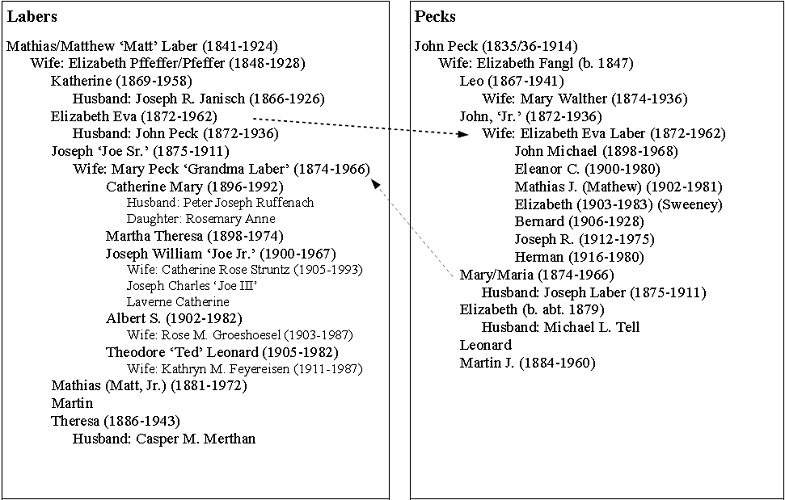 Family trees of the Laber and Peck families, showing the interconnections. Endnotes: [1] Although Andau is the village name that has come down to descendants of the 1888 immigrants, at the time of their departure, the village would have been known by its Hungarian name: Mosontarcsa. [2] Similarly, St. Andrä—actually Sankt Andrä am Zicksee in German—was known by its Hungarian name: Mosonszentandrás. [3] Prior to 1918, most Austro-Hungarians left Europe from North Sea ports Hamburg, Bremen, Rotterdam, Antwerp or English Channel port Le Harve. Ship facilities on this northern route were considered superior to those on ships leaving through Mediterranean ports. [4] Reverend Locnikar was assigned to Assumption parish at the time and later became the Abbot at St. John’s Monastery. [5] Dean’s Tavern remains at 1986 Rice Street; it has been moved back from the roadway three times and is no longer owned by the Dean family. |
||||||||||||||||||||||||||||||||||||||||||||||||||||||||||||||||||||||||||||||||||||||||||
6) HISTORICAL BB NEWSLETTER ARTICLES Editor: This is part of our series designed to recycle interesting articles from the BB Newsletters of 10 years ago, however, this month I'm taking you back 15 years, as nothing from ten years ago tweaked my interest. This article speaks of conditions in Burgenland during the years right after WW-II and during the Russian occupation. THE BURGENLAND BUNCH NEWS - No. 90A November 30, 2000 RUDERSDORF KRIEGSKINDER (RUDERSDORF CHILDREN OF THE WAR YEARS) - by Robert F. Unger 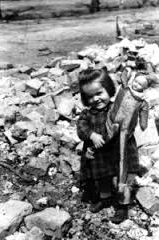 Back
in January '98, I received a copy of the Rudersdorf newspaper which included an article entitled
Kriegskinder that caught my attention. It presented an interesting profile of the life
and the activities of the school children in Rudersdorf, Burgenland, after World War II. These
were Rudersdorf children who were born during the period 1939-1942. Thus they were born during
WW-II and experienced that war and the subsequent Russian occupation of Burgenland during the
period when the Allies occupied all of Austria. Fifty years later, these children held a reunion
in Rudersdorf on 18 October 1997. One of my relatives, Ingrid Unger, was among them. It was
interesting to note that, like Ingrid, most of these children still reside in Rudersdorf.
Following is an article from "Der Bankerlsitzer" covering that reunion, translated from
German to English. My wife and I met the editor of Der Bankerlsitzer, Herr Peter Sattler,
during a 1997 visit and we have been corresponding via email ever since. We are very thankful to
Herr Sattler for allowing the following English translation of his Kriegskinder article
for the enjoyment and enlightenment of the Burgenland Bunch members. Back
in January '98, I received a copy of the Rudersdorf newspaper which included an article entitled
Kriegskinder that caught my attention. It presented an interesting profile of the life
and the activities of the school children in Rudersdorf, Burgenland, after World War II. These
were Rudersdorf children who were born during the period 1939-1942. Thus they were born during
WW-II and experienced that war and the subsequent Russian occupation of Burgenland during the
period when the Allies occupied all of Austria. Fifty years later, these children held a reunion
in Rudersdorf on 18 October 1997. One of my relatives, Ingrid Unger, was among them. It was
interesting to note that, like Ingrid, most of these children still reside in Rudersdorf.
Following is an article from "Der Bankerlsitzer" covering that reunion, translated from
German to English. My wife and I met the editor of Der Bankerlsitzer, Herr Peter Sattler,
during a 1997 visit and we have been corresponding via email ever since. We are very thankful to
Herr Sattler for allowing the following English translation of his Kriegskinder article
for the enjoyment and enlightenment of the Burgenland Bunch members. War Children - Kriegskinder Karl Himler, originally from Rudersdorf, who was born during the war [WW-II] and went to school in Rudersdorf in the years after the war, brought the comrades of his childhood together in the Pfingstl Inn on 18 October 1997 for a reunion. He planned this from his current home in Germany and it all worked out. Approximately 50 alumni, born from 1939-1942, came. Their motivations for attending were nostalgia, home-sickness, the memories of childhood and youth, and the chance to meet with one another again. The war was indeed over when they went to school 50 years ago, but prosperity had definitely not yet returned. Clothes and shoes were in short supply, sausage rolls were seldom seen, TV's and bananas were widely unknown. Water came from wells and was actually drunk by people, which nowadays is hard to imagine. In the apartments - which were mostly a kitchen and one room - usually only one area was heated. Big families still had there own cozy areas. The memories of ice-cold bedrooms, of substitute coffee [made from barley or wheat, because coffee beans were not available or too expensive], and of the [pump?] toilet [German word Plumpsklo] are still alive today. The professions of the fathers of the war children in Rudersdorf were farmer, factory worker, tailor, shoemaker, bricklayer, carpenter, hotel host, merchant, baker, and teacher. Everyone had a reduced income. Some had been claimed by the war [note: I think this means they did not return, i.e. they were killed or missing]. The goods in the stores, named for the owners: Unger, Doppler, Pfingstl, Eichner and Winter (Hartl), were sold unpackaged. They were counted, weighed, or measured and packed into newspaper and paper sacks, or poured into bottles; marmalade, sugar, and axle grease came out of tins; vinegar, paraffin and rum came out of casks; leather whips, whip handles, muzzles, calf and horse ropes, whetstones, and animal straps stood in a particular corner of the store. Naturally there were various nails, screws and fittings for working wood. According to the season, school supplies, plum compote, or Christmas decorations lay on the display table. Nylons were unheard of. When they were introduced in 1954, their transparency caused quite a stir. Those transparent stockings had not been seen up to that time. The first ballpoint pens also appeared. Tales told by American returnees were received as wonders: tales that had to do with refrigerators, food from cans, electric stoves where one didn't have to light a fire, and of shoes that one discarded instead of repairing. The elementary school at that time still had an upper grade with teaching by subject. The teachers for shorter or longer periods were Josef Tausz, Stefan Dujmovits, Maria Kohl, Theresia Schnecker, Adolf Perl, Otto Roth, Emma Hölzl, Erich Krutzler and Hermine and Eduard Fröhlich. A pen dipped in ink was used for writing. Ink was kept in glass (inkwells) in the desk. Other utensils: the (slate) board with chalk, cloth, and sponge; the wooden box; the oven; the map; pictures on the wall; the sandbox; stuffed animals and the (teacher's) staff, later a pointer or meter stick. To eat, there was mostly bread with lard and apples; for better food, there was bread with lard cracklings or ham. The schoolchildren, who went to the high school (Gymnasium) or the trade school (Hauptschule) in Fürstenfeld (Styria) after the fourth grade, were integrated in the village because free time was spent only at home. There was no vacation in today's sense. Everyone knew everyone in the village. The Russian occupation forces kept watch on the Lafnitz (the area river) and were present in public. The English patrolled the far river bank from a barracks that was later torn down and rebuilt in Neustift bei Güssing. It is still serving there as a residential building. (Editorial Note: Rudersdorf is located 16 kilometers (about 9 1/2 miles) west of Güssing and is at the edge of the border between the Austrian provinces of Burgenland and Styria, separated there by the Lafnitz River. After WW-II, Styria was occupied by the British and Burgenland by the Russians.) In Rudersdorf, before the war, there were 5 cars and 2 tractors; these disappeared during the war (fuel shortage), however. The car owners before the war were Josef Eichner (Steyr 12), Michael Fritz (Mercedes), Karl Bösenhofer (Tatra), Andreas Doppler (Tatra, Horch or Adler) and Romuald Schabhüttl (Steyr). Tractors were owned by Rudolf Karner in Nr. 51 (Steyr) and a cooperative, whose leader was Franz König in Nr. 47 (Deutz). (Editorial Note: One of the car owners, Karl Bösenhofer, was one of my relatives. Romuald Schabhüttl, butcher and Gasthaus Wirt, a cousin of Gerry Berghold on the Berghold side.) Adolf Brunner was mayor at that time. (A picture of Adolf was included in the original text.) Nature and climate determined the cycle of life. Horse- and ox-carts ruled the streets. Chickens, ducks, geese and the occasional huge turkey wandered by the farm house gates. The children were familiar with the wild animals, birds, and fish around the village. The bank was only open on Sunday mornings. The whole village was our playground. Front yards, backyards, barns, Halbböden (= "Heuboden" or hay loft), piles of straw, the woods, meadows, Lahn (the local river/stream) and Steinriegel (a hill in Rudersdorf). Boys and girls played "Ball on the Wall" and "hop-scotch"; the older children "Drive the ball" and the boys played "cops and robbers", "shove the cross?" and, above all, soccer. Soccer was played in cloth pants, the shirt-tail worn outside your pants. A header with the wet leather ball -- which often went in the Lahn and was supposed to have been impregnated with bacon grease -- I'll always remember that. Skates were made of wood and fit like the skates on the soles of the goiserer (Austrian mountain shoes). They were called screw steamers because the skates were screwed on to the shoes with a clamp. Everyone wore goiserer -- winter shoes that were good for bad weather, work, and sports because they were nailed together. The first soccer games with these shoes played in the deep wet spring grass were spectacular. The standard leggings were lederhosen -- short and tied at the knee, the so-called "pump pants". They outlasted many a child but, over time, became shinier and shinier and ranker and ranker as they became smeared with grease. School kids at home frequently were put to work. Most of them knew how to handle cattle. Everyone knew the work of the tailor, the cobbler, the wheelwright, the carpenter, the saddlemaker and the blacksmith because, for different reasons, they had visited their workshops. Working together to strip quills, to peel fruit, to chuck corn [Kukuruz is the Austrian/Hungarian term, in German it is Mais], to make hay or to cut and thresh grain were of interest. All worked together and one learned each job better. It was sad that later, in the early 50s, there was not enough work for everybody in the village, because nobody liked to move away from their friends. Later, when they were almost 60, meeting again was a joy, because there was so much to talk about. What happened to all of them? (Note: At the end of the article, the names of all the 86 individuals involved were listed, including 11 who had died. A group picture was also included. One former student came from Canada, and another from Los Angeles, CA.) (Ed. [Gerry] Note: As described, conditions were pretty bad following WW-II and, as a result, there was a new wave of emigration in the 1950s, particularly from the Russian Zone, with Canada receiving a large number from this wave. Some of these later returned to the Burgenland. My wife and I shared a church bus trip with a group from Eltendorf to Styria one fine Saturday in the Fall of 1993. Everyone on the bus spoke only German except one young mother with three children, who also spoke English. Turns out she had emigrated to Canada during this period and later returned. She said she had been homesick for the Burgenland, but now she also missed Canada, but home was home "Heimat sind Heimat." I imagine this is a common returning emigrant dilemma. Following my last trip to Austria in 1999, I can report that conditions are now similar to those in the United States. Most traces of "Old Europe" have passed into history.) |
||||||||||||||||||||||||||||||||||||||||||||||||||||||||||||||||||||||||||||||||||||||||||
7) ETHNIC EVENTS LEHIGH VALLEY, PA Friday, November 27-Sunday, December 20: Christkindlmarkt in Bethlehem. Info: www.christmascity.org/christkindlmarkt/event-info Friday, November 27-Sunday, December 20: Weihnachtsmarkt in Bethlehem. Info: www.downtownbethlehemassociation.com/events/christmas-city-village Tuesday, December 1: German-English Advent-Singstunde at Central Moravian Church in Bethlehem. Info: www.christmascity.org/event/1945/german-and-english-advent-singstunde/ Wednesday, December 2: German Christmas Show at the Evergreen Heimatbund in Fleetwood. Info: www.evergreenclub.org Saturday, December 5: Christmas Concert of the Lancaster Liederkranz Chorus at Zion Evangelical Lutheran Church in Landisville. Info: www.lancasterliederkranz.com Saturday, December 5: Christmas Dinner & Dance at the Lancaster Liederkranz. Music by the Joseph Weber Orchestra. Info: www.lancasterliederkranz.com Sunday, December 6: Christkindlmarkt at the Reading Liederkranz. Info: www.readingliederkranz.com/christkindlmarkt Wednesday, December 9: Deutscher Gemütlichkeit Abend at the Reading Liederkranz. Info: www.readingliederkranz.com Saturday, December 12: Christmas Concert and Dance at the Coplay Sängerbund. Music by the Coplay Sängerbund Mixed Chorus and the Joseph Weber Orchestra. Info: www.coplaysaengerbund.com Sunday, December 13: Christmas Dance at the Holy Family Club in Nazareth. Music by the Walt Groller Orchestra. Info: www.holyfamilyclub.com Thursday, December 31: Silvesterball at the Reading Liederkranz. Music by the Walt Groller Orchestra. Info: www.readingliederkranz.com Thursday, December 31: New Year's Eve at the Lancaster Liederkranz. Music by the Maria & John Quartet. Info: www.lancasterliederkranz.com Thursday, December 31: New Year's Eve at the Evergreen Heimatbund in Fleetwood. Music by the Josef Kroboth Orchestra. Info: www.evergreenclub.org NEW BRITAIN, CT Friday, December 4, 7 pm: Heimat Abend. Austrian Donau Club, 545 Arch Street, $3. Music by Joe Rogers and his band. Saturday, December 5: Donau Holiday Fair & Christkindlmarkt. Austrian Donau Club, 545 Arch Street. Friday, December 18, 7:30 pm: Heurigan Abend. Austrian Donau Club, 545 Arch Street, $3. Music by Schachtelgebirger Musikanten. |
||||||||||||||||||||||||||||||||||||||||||||||||||||||||||||||||||||||||||||||||||||||||||
8) BURGENLAND EMIGRANT OBITUARIES Adolph Razz (Racz)  Adolph
Edward Razz, 88, resident of Highland, New York, and formally of Poughkeepsie, entered into
eternal rest on November 9, 2015 in Hospice care at the VA Hospital in Montrose, NY. The cause
of death was due to Alzheimer's disease. Adolph
Edward Razz, 88, resident of Highland, New York, and formally of Poughkeepsie, entered into
eternal rest on November 9, 2015 in Hospice care at the VA Hospital in Montrose, NY. The cause
of death was due to Alzheimer's disease.Born October 7, 1927 in Tobaj, Austria, he was the son of the late Joseph and Valerie (Raubold) Racz. He was a World War II veteran and served in Japan during the post war occupation period. Following his service, he was employed by IBM as an engineer for 38 years. Adolph enjoyed the outdoors and working on the farm of his youth where he eventually retired. He built his first home in Poughkeepsie and later a home in Highland in his retirement. In his younger years Adolph enjoyed bowling, skiing and volunteering as a baseball coach. Adolph absolutely loved Polka dancing and listening to German folk music. He had a generous heart and would offer help to anyone from fixing leaky faucets to helping them with their taxes. He married Hildegard M. Olson in St Charles Borromeo Church in Gardiner, NY on November 22, 1952. He was a former member of Holy Trinity Church in Poughkeepsie and a communicant of St. Joseph's Church in New Paltz in his retirement. In addition to his parents, Adolph was predeceased by his siblings, Joseph Racz, Pauline Zettle, Helen Racz and a son, Christopher in 1974. He is survived by his sons and (spouses), Dr. Erick (Gina) J. Razz of San Jose, CA, Mr. Joseph (Christine) A. Razz of Brookfield, CT and Mr. Edward (Kathleen) A. Razz of Clifton Park, NY. His grandchildren include Kerri Quezada, Danny Franklin, Taryn Rechenmacher, Sarah Holleran, Andrew Razz, Jamie Razz, April Cuomo, Daniel Cuomo, Jennelle McGovern, Kirsten Razz and seven more great grandchildren. Several wonderful nieces and nephews survive him as well. Calling hours will be Friday from 4-7pm at the Copeland's Funeral Home, 162 South Putt Corners Road, New Paltz, NY. A Mass of the Christian Burial will be offered on Saturday at 11am at St. Joseph's Church, 34 S Chestnut St, New Paltz, NY followed by military honors. Burial is planned for Monday at 10am at St. Peter's Cemetery in Poughkeepsie. The funeral procession will start at 9am at Copeland's Funeral Home. In lieu of flowers, contributions may be made to the Alzheimer's Association - Northeastern New York, 4 Pine West Plaza, Suite 405, Albany, NY 12205. Arrangements are under the direction of Copeland Funeral Home, Inc., 162 South Putt Corners Road, New Paltz, NY 12561. To send a condolence or for directions, visit www.copelandfhnp.com Published in the Poughkeepsie Journal on Nov. 12, 2015 Elizabeth Croft (née Trummer)  Elizabeth
Croft, 89, born Erzsébet Trummer on October 8, 1926, in Mosonszolnok (Zanegg), Hungary, died
peacefully with family present in Tallahassee, Florida, on Tuesday, November 17, 2015. Elizabeth
Croft, 89, born Erzsébet Trummer on October 8, 1926, in Mosonszolnok (Zanegg), Hungary, died
peacefully with family present in Tallahassee, Florida, on Tuesday, November 17, 2015.A twelve-year resident of Tallahassee, Elizabeth had previously lived in Jacksonville from 1956 to 2003, where she was a long-time member of St. Catherine's Episcopal Church and, after raising a family, worked in office support for Florida's Department of Health and Rehabilitative Services until her retirement in 1991. Her life took her many places. A refugee in World War II with her family, who in 1945 abandoned Hungary to reach Allied-occupied Europe, she lived in London briefly, working as a nanny while attending business college, and later worked in Heidelberg, West Germany, as a store clerk at a local PX, before she immigrated to the United States. In Tallahassee, she enjoyed attending Holy Comforter Episcopal Church, making embroidery and crafts, taking long walks, and baking cookies for children, neighbors, and lawn-care workers. She is predeceased by her husband Edward Croft from Jacksonville, and brothers Johan, Paul, and Sepp, from Allfeld, Germany. She is survived by daughters Joann Engels (Paul) and Sandy Lent (Mark Bell); son Edward C. Croft; granddaughter Katie Rikansrud (Nate) with great-grandsons Colbin and Hudson Rikansrud; grandson Kyle Lent; sister Theresia Zwickl in Collie, Western Australia; and extended family in Germany, Hungary, Australia, and the United States. Published in Tallahassee Democrat on Nov. 20, 2015 Aloisia Simitz (née Heber)  Aloisia
Simitz, 93, of Whitehall, Pennsylvania, passed away peacefully Wednesday, November 18, 2015. Aloisia
Simitz, 93, of Whitehall, Pennsylvania, passed away peacefully Wednesday, November 18, 2015.She was the widow of the late Alfred Simitz, who died in 1965. Born in Rábafüzes (Raabfidisch), Hungary, she was a daughter of the late Karl and Maria (Zeglowitsch) Heber. Aloisia was a longtime member of St. Elizabeth of Hungary Catholic Church, and their former Altar and Rosary Society, and Women of St. Elizabeth. She worked in the greenhouses of Phoebe Floral for over 27 years, and was a wonderful gardener and cook. Survivors: daughter Linda L. Meckes and her husband Andrew, along with sister Margaret "Gretl" Stibrany and extended family; she was predeceased by 3 siblings. Services: Her Mass of Christian Burial will be celebrated at 10:00 am on Tuesday, November 24, 2015 in St. Elizabeth of Hungary Catholic Church, 618 Fullerton Ave. Whitehall, PA 18052. Visitation with her family will begin at 9:00 am in the Gilbert Funeral Home, 444 Pershing Blvd., Whitehall, across from the Church. Interment will follow in Laurel Cemetery. Contributions: are suggested to the Church. Published in Morning Call on Nov. 22, 2015 |
||||||||||||||||||||||||||||||||||||||||||||||||||||||||||||||||||||||||||||||||||||||||||
| END OF NEWSLETTER (All good things must end!) |
||||||||||||||||||||||||||||||||||||||||||||||||||||||||||||||||||||||||||||||||||||||||||
NOTICE (Terms and Conditions): The Burgenland Bunch (BB) was formed and exists to assist Burgenland descendants in their research into their heritage and, toward that end, reserves the right to use any communication you have with us (email, letter, phone conversation, etc.) as part of our information exchange and educational research efforts. • If you do not want your communication to be used for this purpose, indicate that it is "confidential" and we will abide by that request. • Correspondents who communicate with the BB without requesting confidentiality retain their copyright but give a non-exclusive license to the BB allowing us to forward to BB members, publish in our monthly newsletter or on our website, and/or subsequently and permanently archive all or parts of such communications. The Burgenland Bunch homepage (website) can be found at: http://www.the-burgenland-bunch.org Burgenland Bunch Newsletter, copyright © 2015 by The Burgenland Bunch All rights reserved. Permission to copy excerpts granted if credit is provided. |
 News
News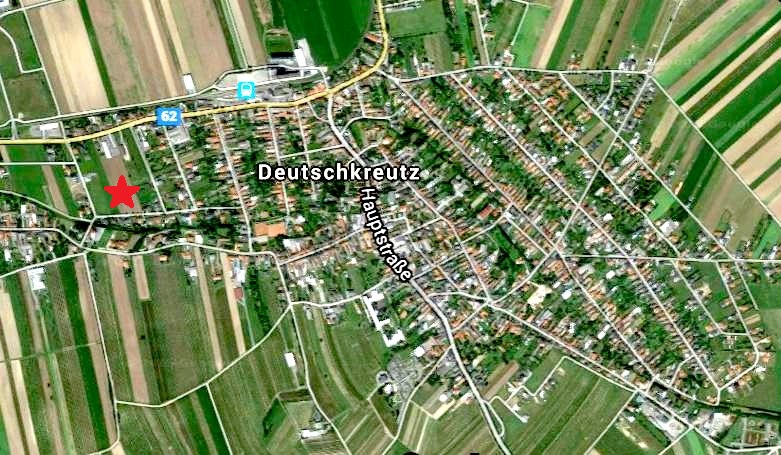
 GEDmatch
– The Basics: If you have had an autosomal test performed, you likely are aware of
GEDmatch.com, a site that accepts (free of charge) autosomal results generated by the three
major DNA testing companies. Currently, there are about 120,000 kits (result sets) uploaded to
GEDmatch. However, AncestryDNA and 23andMe each have over one million kits
on their sites and FamilyTreeDNA is approaching 200,000 kits. With the pool of kits
available for transfer so high, the long-run potential for ever-increasing uploads to GEDmatch
is indeed significant.
GEDmatch
– The Basics: If you have had an autosomal test performed, you likely are aware of
GEDmatch.com, a site that accepts (free of charge) autosomal results generated by the three
major DNA testing companies. Currently, there are about 120,000 kits (result sets) uploaded to
GEDmatch. However, AncestryDNA and 23andMe each have over one million kits
on their sites and FamilyTreeDNA is approaching 200,000 kits. With the pool of kits
available for transfer so high, the long-run potential for ever-increasing uploads to GEDmatch
is indeed significant. New
Kid on the DNA Block: Recent start-up DNA.Land (
New
Kid on the DNA Block: Recent start-up DNA.Land (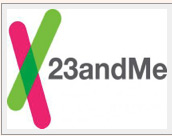 23andMe
Now Includes Reports That Meet FDA Standards: Anne Wojcicki, CEO of 23andMe,
released a note on Oct. 21, 2015 that, as she says, "...marks a great milestone in the
history of personal genetics. I am thrilled to let you know that 23andMe is now the first
and only genetic service available directly to you that includes reports that meet FDA
standards."
23andMe
Now Includes Reports That Meet FDA Standards: Anne Wojcicki, CEO of 23andMe,
released a note on Oct. 21, 2015 that, as she says, "...marks a great milestone in the
history of personal genetics. I am thrilled to let you know that 23andMe is now the first
and only genetic service available directly to you that includes reports that meet FDA
standards." Canadian
Naturalization Database Expanded: Library and Archives Canada is pleased to
announce the release of a new version of the online database,
Canadian
Naturalization Database Expanded: Library and Archives Canada is pleased to
announce the release of a new version of the online database,
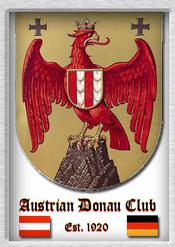 Kudos
to the Austrian Donau Society: We applaud the Austrian Donau Society of New
Britain, CT, for granting annual scholarships to deserving high school seniors, with special
consideration given to students of Austrian/German descent. Dennis Kern, the current president
of the society said the goal is to recognize the achievements of our youth and help them attain
the dream of a higher education. Over the past seven years, close to $20,000 in awards have been
given out.
Kudos
to the Austrian Donau Society: We applaud the Austrian Donau Society of New
Britain, CT, for granting annual scholarships to deserving high school seniors, with special
consideration given to students of Austrian/German descent. Dennis Kern, the current president
of the society said the goal is to recognize the achievements of our youth and help them attain
the dream of a higher education. Over the past seven years, close to $20,000 in awards have been
given out.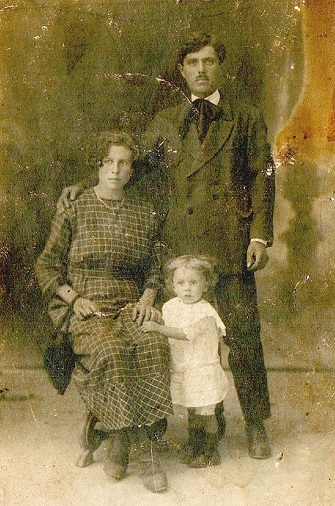 Betty
write (in part): Dear Tom, I'm very pleased to send you a photograph, dated 1858, of my
great-grandmother Anna (the baby) with her parents. Anna was born 05/06/1856 in Gyanafalva
[Jennersdorf, Burgenland].
Betty
write (in part): Dear Tom, I'm very pleased to send you a photograph, dated 1858, of my
great-grandmother Anna (the baby) with her parents. Anna was born 05/06/1856 in Gyanafalva
[Jennersdorf, Burgenland].  Locate
a Loved One: The Diocese of Brooklyn "Catholic Cemeteries" has announced its new
Locate a Loved One search engine. The database is searchable by full or partial surname.
Given names are optional unless there are too many hits on the surname alone. The database
reports the interred's full name, interment date and location, a cemetery map and directions,
including the crypt/niche or section, row, and grave number. Further details, such as age of
deceased, death date, and gravestone photos, may be obtained for a fee.
Locate
a Loved One: The Diocese of Brooklyn "Catholic Cemeteries" has announced its new
Locate a Loved One search engine. The database is searchable by full or partial surname.
Given names are optional unless there are too many hits on the surname alone. The database
reports the interred's full name, interment date and location, a cemetery map and directions,
including the crypt/niche or section, row, and grave number. Further details, such as age of
deceased, death date, and gravestone photos, may be obtained for a fee. Update
for book "The Burgenländer Emigration to America": Here is this month's update on
purchases of the English issue of the 3rd edition of Dr. Walter Dujmovits' book "Die
Amerika-Wanderung Der Burgenländer."
Update
for book "The Burgenländer Emigration to America": Here is this month's update on
purchases of the English issue of the 3rd edition of Dr. Walter Dujmovits' book "Die
Amerika-Wanderung Der Burgenländer."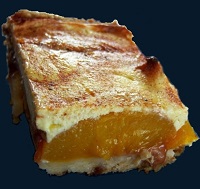 PEACH
KUCHEN
PEACH
KUCHEN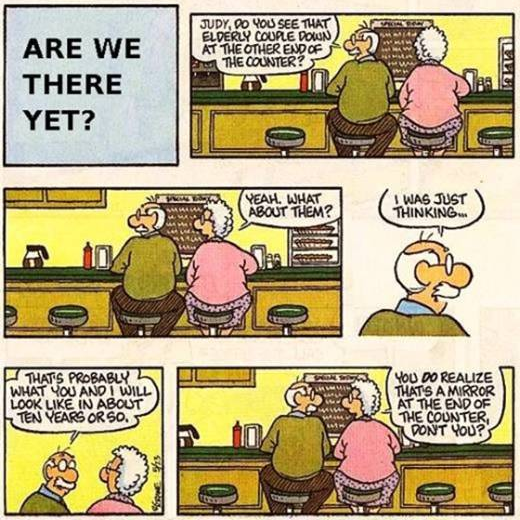
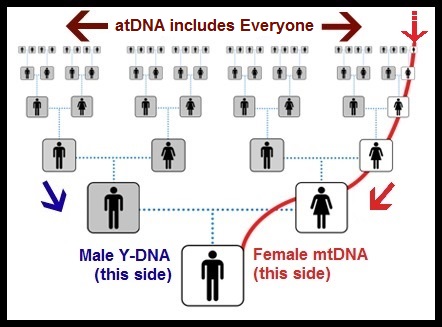 Mitochondrial
DNA, however, comes only from your mother's maternal line, as only females can pass it
along (as the media in the egg that surrounds the nucleus). Rather than being recombined (mixed)
at each generation, it is passed unchanged from mother to child (male or female). If it were not
for mutations, all humans would share identical mtDNA. But mutations do occur, so mtDNA
changes... though very slowly (still, mitochondrial mutations occur 5-10 times more rapidly than
nuclear DNA mutations).
Mitochondrial
DNA, however, comes only from your mother's maternal line, as only females can pass it
along (as the media in the egg that surrounds the nucleus). Rather than being recombined (mixed)
at each generation, it is passed unchanged from mother to child (male or female). If it were not
for mutations, all humans would share identical mtDNA. But mutations do occur, so mtDNA
changes... though very slowly (still, mitochondrial mutations occur 5-10 times more rapidly than
nuclear DNA mutations). 